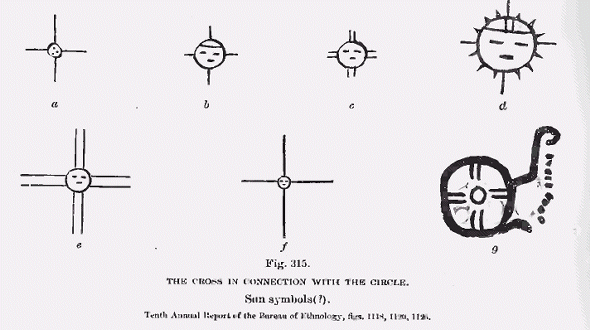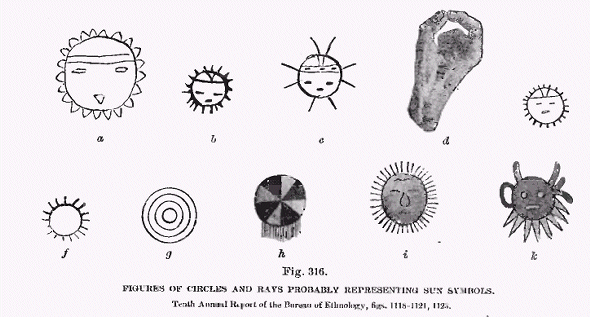|
The Swastika
The Cross Among The American Indians
Page 115
Sun
and star symbols. --- Great speculation has been made, both in Europe
and America, over the relation between the Swastika and the sun, because
the two signs have been associated by primitive peoples. Colonel Mallery
gives the Indian signs of the sun, stars, and light. (1)
These have been segregated, and it will be seen that the cross and circle
are used indiscriminately for one and the other, and the fact of the two
being found associated is no evidence of relationship in religious ideas
(figs. 315, 316, 317, 318 and 319).
 Dwellings.
---Among the Hidatsa, the cross and the circle represent neither the sun
nor any religious ideas, but merely lodges, houses, or dwellings. The
crosses in fig. 319 represent
Dakota lodges; the small circles signify earth lodges, the points representing
the supporting poles. Buildings erected by civilized people were represented
by small rectangular figures, while the circles with dots in a square
represent earth lodges, the home of the Hidatsa.
Dwellings.
---Among the Hidatsa, the cross and the circle represent neither the sun
nor any religious ideas, but merely lodges, houses, or dwellings. The
crosses in fig. 319 represent
Dakota lodges; the small circles signify earth lodges, the points representing
the supporting poles. Buildings erected by civilized people were represented
by small rectangular figures, while the circles with dots in a square
represent earth lodges, the home of the Hidatsa.
 Dragon
fly (Susbeca). --- Among some of the Indian tribes, the Dakotas
among others, the Latin cross is found, i.e., upright with three members
of equal length and the fourth, the foot, much longer. The use of this
symbol antedates the discovery of America, and is carried back in tradition
and myth. This sign signifies the mosquito hawk or the dragon fly (fig.
320). It is called in that language the "Susbeca," and is
a supernatural being gifted with speech, warning man of danger, approaching
his ear silently and at right angles, saying, "Tci," Tei,"
"Tci," an interjection equivalent to "Look out!" "You
are surely going to destruction!" "Look out!" "Tci,"
"tci," "tei!" The adoption of the dragon fly as a
mysterious and supernatural being is on account of its sudden appearance
in numbers. In the still of the evening, when the shades of darkness come,
then is heard in the meadows a sound as of crickets or frogs, but indistinct
and prolonged; on the morrow the Susbeca will be hovering over it. It
is the sound of their coming, but whence no one knows. The cross not only
represents the shape of the insect, but also the angle of its approach.
It is variously drawn, but usually as in
fig. 320 a or b, and, in painting or embroidery,
c, and sometimes d.
Dragon
fly (Susbeca). --- Among some of the Indian tribes, the Dakotas
among others, the Latin cross is found, i.e., upright with three members
of equal length and the fourth, the foot, much longer. The use of this
symbol antedates the discovery of America, and is carried back in tradition
and myth. This sign signifies the mosquito hawk or the dragon fly (fig.
320). It is called in that language the "Susbeca," and is
a supernatural being gifted with speech, warning man of danger, approaching
his ear silently and at right angles, saying, "Tci," Tei,"
"Tci," an interjection equivalent to "Look out!" "You
are surely going to destruction!" "Look out!" "Tci,"
"tci," "tei!" The adoption of the dragon fly as a
mysterious and supernatural being is on account of its sudden appearance
in numbers. In the still of the evening, when the shades of darkness come,
then is heard in the meadows a sound as of crickets or frogs, but indistinct
and prolonged; on the morrow the Susbeca will be hovering over it. It
is the sound of their coming, but whence no one knows. The cross not only
represents the shape of the insect, but also the angle of its approach.
It is variously drawn, but usually as in
fig. 320 a or b, and, in painting or embroidery,
c, and sometimes d.
Fig.
321 is described in Keam's MS. as follows:
This is a conventional design of dragon
flies, and is often found among rock etchings throughout the plateau [Arizona].
the dragon flies have always been held in great veneration by the Mokis
and their ancestors, as they have been often sent by Oman to reopen springs
which Muingwa had destroyed and to confer other benefits upon the people.
 This form of the figure, with little vertical lines added to the transverse
lines, connects the Ratolatei with the Ho-bo-bo emblems. The youth who
was sacrificed and translated by Ho-bo-bo reappeared a long time afterwards,
during a season of great drought, in the form of a gigantic dragon fly,
who led the rain clouds over the lands of Ho-pi-tu, bringing plenteous
rains.
This form of the figure, with little vertical lines added to the transverse
lines, connects the Ratolatei with the Ho-bo-bo emblems. The youth who
was sacrificed and translated by Ho-bo-bo reappeared a long time afterwards,
during a season of great drought, in the form of a gigantic dragon fly,
who led the rain clouds over the lands of Ho-pi-tu, bringing plenteous
rains.

Midé or Shamans. ---
Colonel Mallery (or Dr. Hoffman) tells us (p. 726) that among the Ojibways
of northern Minnesota the cross is one of the sacred symbols of the Society
of Midé or Shamans and has special reference to the fourth degree.
The building in which the initiation is carried on has its opening toward
the four cardinal points. The cross is made of saplings, the upright poles
approaching the height of four to six feet, the transverse arms being
somewhat shorter, each being of the same length as the top; the upper
parts are painted white or besmeared with white clay, over which are spread
small spots of red, the latter suggesting the sacred shell of Midé,
the symbol of the order. The lower arm of the pole is square, the side
toward the east being painted white to denote the source of light and
warmth; the face on the south is green, denoting the source of the thunder
bird which brings the rains and vegetation; the surface toward the west
is covered with vermilion, relating to the land of the setting sun, the
abode of the dead; the north is painted black, as the direction from which
comes affliction, cold, and hunger.
Flocks of birds. --- Groups
of small crosses on the sides of Eskimo bow
ENDNOTES:
1.
Tenth Ann. Rep. Bureau of Ethnology, 1888-89, figs. 1118-1129. [Back]
<< Previous Page
Next
Page >>
© 2004-2007 Northvegr.
Most of the material on this site is in the public domain. However, many people have worked very hard to bring these texts to you so if you do use the work, we would appreciate it if you could give credit to both the Northvegr site and to the individuals who worked to bring you these texts. A small number of texts are copyrighted and cannot be used without the author's permission. Any text that is copyrighted will have a clear notation of such on the main index page for that text. Inquiries
can be sent to info@northvegr.org.
Northvegr™ and the Northvegr symbol are trademarks and service marks
of the Northvegr Foundation.
|
> Northvegr™ Foundation
>> About Northvegr Foundation
>> What's New
>> Contact Info
>> Link to Us
>> E-mail Updates
>> Links
>> Mailing Lists
>> Statement of Purpose
>> Socio-Political Stance
>> Donate
> The Vík - Online Store
>> More Norse Merchandise
> Advertise With Us
> Heithni
>> Books & Articles
>> Trúlög
>> Sögumál
>>
Heithinn Date Calculator
>> Recommended Reading
>>
The 30 Northern Virtues
> Recommended Heithinn Faith Organizations
>> Alfaleith.org
> NESP
>> Transcribe Texts
>> Translate Texts
>> HTML Coding
>> PDF Construction
> N. European Studies
>> Texts
>> Texts in PDF Format
>> NESP Reviews
>> Germanic Sources
>> Roman Scandinavia
>> Maps
> Language Resources
>> Zoëga Old Icelandic Dict.
>> Cleasby-Vigfusson Dictionary
>> Sweet's Old Icelandic Primer
>> Old Icelandic Grammar
>> Holy Language Lexicon
>> Old English Lexicon
>> Gothic Grammar Project
>> Old English Project
>> Language Resources
> Northern Family
>> Northern Fairy Tales
>> Norse-ery Rhymes
>>
Children's Books/Links
>> Tafl
>> Northern Recipes
>> Kubb
> Other Sections
>> The Holy Fylfot
>> Tradition Roots

Please Visit Our Sponsors
- Référencement
- Alfaleith.org - Heithni, Viðartrú
- Odin's Journey
- Baman - Iceland/Aboriginal Australia
- Biker's Booty
- Création site Internet Paris
- Pagan T-shirts
- Appartements
- Chalets au Québec
- Logo Designers
- Web Design
- Appartements Montreal
- Espace Bureau Montreal
- London Tours
- Spanish Property Legal Advice
- Multi Pret Hypotheque
- Company Logo Design
- Wiccan T-shirts
- Art Gallery, Painting artists
- free logo design reviews
- Heathen, Heathenism, Norse Pagan
- Logo design by LogoBee
- Pagan Shirts
- Norse Pagan Religion
- Triumph, BSA, Norton, Euro Motorcycles - Accessories
- Logo Maker
- Logo Design - Business Logos, Inc.
- Logo Design - Logo Maker
- Create A Website
- Wiccan Shirts
- Mortgages
- Multi-Prêts Hypothèques
- Viking T-shirts
- Hewlett Packard Ink Cartridges
- Indian Recipes
- Logo Design London
- Logo Design
- Logo Design UK
- Subvention et financement PME
- Heathen T-shirts
- Medical Alert, Emergency response
- orlando hotels
- Slot Machines for Vikings
- Norse Pagan Clothing and Merchandise
- New Homes
- Branding Irons
- Bachelor Degree Online
- Online Degree
- College Degree
- Heathen, Viking and Norse Texts
- Création site Internet
- Montreal Web Design
- Free Dish Network Satellite TV
- Discount ink cartridge & laser cartridge
- DUI Lawyers & DWI Attorneys
- Promotional Products
- Ready-Made Company Logos
- Canadian Art Dealer
- Best CD Rates
- Laser Toner Cartridge
- Logotyper & Grafiska Profilprogram
- Banner Design
- Custom Logo Design
Web site design and coding by Golden Boar Creations
|
|






